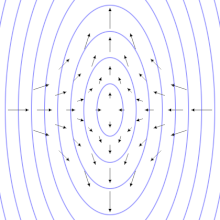Gravitational waves are ripples in the curvature of spacetime caused by some vibrant and energetic processes that propagate as waves, generated in certain gravitational interactions and travelling outward from their source. Predicted in 1916[1][2] by Albert Einstein on the basis of his theory ofgeneral relativity,[3][4] gravitational waves transport energy as gravitational radiation, a form of radiant energy similar toelectromagnetic radiation. Gravitational waves cannot exist in the Newtonian theory of gravitation, since Newtonian theory postulates that physical interactions propagate at infinite speed.
Although it was predicted a long time ago but it was not until now that we have actually detected it with the help of cosmic neutrinos.
Although it was predicted a long time ago but it was not until now that we have actually detected it with the help of cosmic neutrinos.
In Einstein's theory of general relativity, gravity is treated as a phenomenon resulting from the curvature of spacetime. This curvature is caused by the presence of mass. Generally, the more mass that is contained within a given volume of space, the greater the curvature of spacetime will be at the boundary of its volume.[12] As objects with mass move around in spacetime, the curvature changes to reflect the changed locations of those objects. In certain circumstances, accelerating objects generate changes in this curvature, which propagate outwards at the speed of light in a wave-like manner. These propagating phenomena are known as gravitational waves.
As a gravitational wave passes an observer, that observer will find spacetime distorted by the effects of strain. Distances between objects increase and decrease rhythmically as the wave passes, at a frequency corresponding to that of the wave. This occurs despite such free objects never being subjected to an unbalanced force. The magnitude of this effect decreases proportional to the inverse distance from the source.[citation needed] Inspiraling binary neutron stars are predicted to be a powerful source of gravitational waves as they coalesce, due to the very large acceleration of their masses as they orbit close to one another. However, due to the astronomical distances to these sources, the effects when measured on Earth are predicted to be very small, having strains of less than 1 part in 1020. Scientists have demonstrated the existence of these waves with ever more sensitive detectors. The most sensitive detector accomplished the task possessing a sensitivity measurement of about one part in 5×1022 (as of 2012) provided by the LIGO and VIRGO observatories.[13] A space based observatory, the Laser Interferometer Space Antenna, is currently under development by ESA.
Gravitational waves can penetrate regions of space that electromagnetic waves cannot. They are able to allow the observation of the merger of black holes and possibly other exotic objects in the distant Universe. Such systems cannot be observed with more traditional means such as optical telescopes or radio telescopes, and so gravitational-wave astronomy gives new insights into the working of the Universe. In particular, gravitational waves could be of interest to cosmologists as they offer a possible way of observing the very early Universe. This is not possible with conventional astronomy, since before recombination the Universe was opaque to electromagnetic radiation.[14] Precise measurements of gravitational waves will also allow scientists to more thoroughly test the general theory of relativity.
In principle, gravitational waves could exist at any frequency. However, very low frequency waves would be impossible to detect and there is no credible source for detectable waves of very high frequency. Stephen Hawking and Werner Israel list different frequency bands for gravitational waves that could plausibly be detected, ranging from 10−7 Hz up to 1011 Hz.[15]
Effects of passing[edit]
Gravitational waves are constantly passing Earth; however, even the strongest have a minuscule effect and their sources are generally at a great distance. For example, the waves given off by the cataclysmic final merger of GW150914 reached Earth after travelling over a billion lightyears, as a ripple in spacetime that changed the length of a 4-km LIGO arm by a ten thousandth of the width of a proton, proportionally equivalent to changing the distance to the nearest star outside the Solar System by one hair's width.[29] This tiny effect from even extreme gravitational waves makes them completely undetectable on Earth, by any means other than the most sophisticated detectors.
The effects of a passing gravitational wave, in an extremely exaggerated form, can be visualized by imagining a perfectly flat region of spacetime with a group of motionless test particles lying in a plane (e.g., the surface of a computer screen). As a gravitational wave passes through the particles along a line perpendicular to the plane of the particles (i.e. following the observer's line of vision into the screen), the particles will follow the distortion in spacetime, oscillating in a "cruciform" manner, as shown in the animations. The area enclosed by the test particles does not change and there is no motion along the direction of propagation.[citation needed]
The oscillations depicted in the animation are exaggerated for the purpose of discussion — in reality a gravitational wave has a very small amplitude(as formulated in linearized gravity). However, they help illustrate the kind of oscillations associated with gravitational waves as produced, for example, by a pair of masses in a circular orbit. In this case the amplitude of the gravitational wave is constant, but its plane of polarization changes or rotates at twice the orbital rate and so the time-varying gravitational wave size (or 'periodic spacetime strain') exhibits a variation as shown in the animation.[30] If the orbit of the masses is elliptical then the gravitational wave's amplitude also varies with time according to Einstein's quadrupole formula.[31]
As with other waves, there are a number of characteristics used to describe a gravitational wave:
- Amplitude: Usually denoted h, this is the size of the wave — the fraction of stretching or squeezing in the animation. The amplitude shown here is roughly h = 0.5 (or 50%). Gravitational waves passing through the Earth are many sextillion times weaker than this — h ≈ 10−20.
- Frequency: Usually denoted f, this is the frequency with which the wave oscillates (1 divided by the amount of time between two successive maximum stretches or squeezes)
- Wavelength: Usually denoted λ, this is the distance along the wave between points of maximum stretch or squeeze.
- Speed: This is the speed at which a point on the wave (for example, a point of maximum stretch or squeeze) travels. For gravitational waves with small amplitudes, this wave speed is equal to the speed of light (c).
Sources[edit]
In general terms, gravitational waves are radiated by objects whose motion involves acceleration, provided that the motion is not perfectly spherically symmetric (like an expanding or contracting sphere) or rotationally symmetric (like a spinning disk or sphere). A simple example of this principle is a spinning dumbbell. If the dumbbell spins around its axis of symmetry, it will not radiate gravitational waves; if it tumbles end over end, as in the case of two planets orbiting each other, it will radiate gravitational waves. The heavier the dumbbell, and the faster it tumbles, the greater is the gravitational radiation it will give off. In an extreme case, such as when the two weights of the dumbbell are massive stars like neutron stars or black holes, orbiting each other quickly, then significant amounts of gravitational radiation would be given off.
Some more detailed examples:
- Two objects orbiting each other in a quasi-Keplerian planar orbit (basically, as a planet would orbit the Sun) will radiate.
- A spinning non-axisymmetric planetoid — say with a large bump or dimple on the equator — willradiate.
- A supernova will radiate except in the unlikely event that the explosion is perfectly symmetric.
- An isolated non-spinning solid object moving at a constant velocity will not radiate. This can be regarded as a consequence of the principle of conservation of linear momentum.
- A spinning disk will not radiate. This can be regarded as a consequence of the principle ofconservation of angular momentum. However, it will show gravitomagnetic effects.
- A spherically pulsating spherical star (non-zero monopole moment or mass, but zero quadrupole moment) will not radiate, in agreement with Birkhoff's theorem.
More technically, the third time derivative of the quadrupole moment (or the l-th time derivative of the l-th multipole moment) of an isolated system's stress–energy tensor must be non-zero in order for it to emit gravitational radiation. This is analogous to the changing dipole moment of charge or current that is necessary for the emission of electromagnetic radiation.




No comments:
Post a Comment